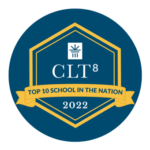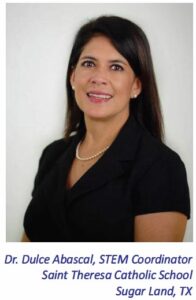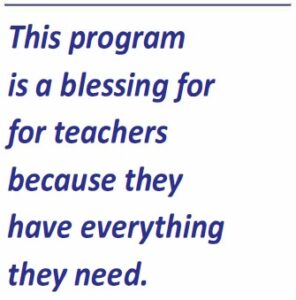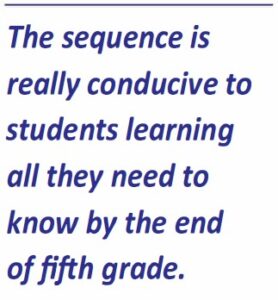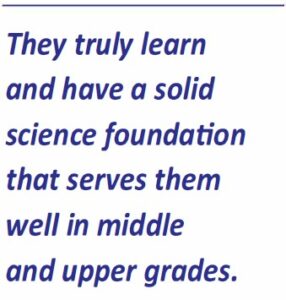Nancy Larson Science —
The choice of a scientist.
An Interview with Dr. Dulce Abascal: Scientist and Classical School STEM Coordinator
It is not every day that we find a Ph.D. scientist choosing to teach at an elementary and middle school. It was our good fortune to discover that Dr. Dulce Abascal, STEM Coordinator of Saint Theresa Catholic School in Sugar Land, Texas, is just such a person. Hearing first-hand from Dr. Abascal led to an insightful interview we wanted to share with you in full.
What is your overall assessment of Nancy Larson Science in your school?
As a scientist/educator, I was very happy to see how solid Nancy Larson Science is in building a strong science foundation. It is a great choice for easy teaching and excellent science content.
We have many different types of schools using our program, but yours is a Classical School. Do you feel it works well within the Classical paradigm?
I do. My teachers and I like how it interrelates to the other subjects. We take the science vocabulary words and talk about the roots of the language. We discuss if the word is Latin or Greek and then they can discuss all these words again in their Latin class. They practice their penmanship with all the writing that they do in the booklets. Since we teach the Socratic method, the way the teacher’s science conversation is written works well with our questioning strategies. The expectation to do presentations is also right in line with what we want them doing. They memorize the presentation about astronomy to present to the class. We get very excited about this program and so do the students. It fits our Classical paradigm quite well.
How did you hear about Nancy Larson Science?
Ms. Pruski, our instructional coordinator, had discovered Nancy Larson Science a few years before I became STEM Coordinator here. She came to me and said that she really wanted to continue to teach Nancy Larson Science because she loves it. She told me that everything you need is there. I said, “Sure, go teach!”
I looked at the program and it is true, everything is prepared for the teacher. Even for teachers that do not have a very big science background, you don’t need it because the lessons are designed with all the knowledge you need as well as the materials.
What do you think makes Nancy Larson Science special?
You can tell a teacher wrote this program. The guided conversation with notes is all you need to be effective at this level. There is no need to worry about finding extra resources. The other thing that we like is that it is NOT a textbook. They have student booklets that they make their own and that helps the students in the lower grade levels handle the materials easily. There are no big books to lose. It is age-appropriate.
We also like that the paragraphs are numbered so it incorporates strategies for reading and teaches to all learning styles. We LOVE the slideshows. The pictures are wonderful. The kids LOVE the slides as well as all the hands-on lessons. They are great. The parents love when the kids bring home their booklets and their projects. It makes for great conversation for our families during dinner time.
Is there anything else that you found valuable about Nancy Larson Science?
I like that it crosses the curriculum. A student will ask “Why are we talking about math during science?” I will respond that they are connected and used together. They also learn that they must write in complete sentences even though it is science and not language arts. These are important skills that are written into this program.
I will ask them “Why did I draw this extra thing?” It makes the students look at what they are doing in a deeper, more meaningful way. They see things in a broader scope. It is real science. It prepares them for the upper grades. Even the 3rd and 4th graders learn about the scientific method, and they learn the process. When they learn this in the early grades, then they know what is coming up and how to approach problems, how to set up an experiment, what you do next, and how you ask your questions. All of these things prepare them for what will be taught in later grades.
Do you see the students enjoying science and how do they feel about the research projects?
Students don’t just do what is required, they do extra! They really enjoy science with these lessons and research projects. It gives them confidence and a desire to learn even more on their own time. They are very passionate about their projects and research.
My own children came home and were doing their research projects. They really loved these projects. Before we knew it, the whole family was involved. In our school, the families tend to be large. Older children comment that they did not learn these topics and are shocked at what their younger siblings are studying. This is really good.
Nancy made a big effort to add in support for both reading and writing. Do you find that these topics are apparent and helpful?
I definitely do find them helpful. These are some of the other outstanding things we love in addition to it being hands-on. It supports reading and writing. In their science booklets, students are taught to highlight the concepts. They know why they need to do this and they see how vital this is, which is a skill in itself. When they get to the later lessons, they already know what they need to do to remember important concepts.
It is our hope that we inspire children to want to become scientists. Do you see children taking a deeper interest in it and talking about wanting to be scientists?
On a personal level I can definitely say that my daughter loves science class and when she comes home, I see her wanting to read more books and learn more about science topics on her own time. I feel it definitely inspires these students to want to be scientists.
We have one young girl who came to tell me that she wants to create a solar car. I love this and I love to see young girls interested in science and wanting to pursue it.
Dr. Abascal, please tell us a little bit about yourself and your interesting background.
I was born and raised in Mexico City and attended a Catholic school for 12 years before going to college to become a scientist. From the time I was a child, I was fascinated by science. I received a chemistry set one Christmas and immediately set up a laboratory in my house where I would spend hours running experiments. It was then that I knew I had to become a scientist
I continued my science education and graduated with honors from the National Autonomous University of Mexico (UNAM) as a Food Chemist and was then granted a scholarship from the University of Guelph in Canada to pursue a Master’s in Food Science.
I returned to Mexico and got married before beginning my studies in Canada. After a couple of years working for a major research institute, I returned to UNAM in pursuit of my doctoral degree, researching emulsions with caseinates, a milk protein. My work helped solve a problem that was facing the food industry. Then while studying from home as a young mother, I completed an additional certificate in Nutrition and Advanced Dietetics through the Universidad Miguel de Cervantes. Science and education are definitely dear to my heart.
In 2013 we moved to Texas and I began volunteering at my local parish. It was then that I decided to obtain my Texas teacher certification, and am now the coordinator for math and STEM as well as the science teacher for 4th through 8th grade science.
Thank you so much for taking the time to talk to us about Nancy Larson Science. Do you have anything else you’d like to share with other teachers and administrators?
Yes. A few comments would be that this program is a blessing for the teachers because they have everything they need. The sequence is really conducive to students learning all they need to know by the end of fifth grade. They truly learn and have a solid science foundation that serves them well in middle and upper grades.
Our teachers even learn new things at these grade levels and the pacing guide is wonderful too. It is so nice to have what you need at your fingertips and to also have the website extensions. Our students really want to extend their lessons and do more in the different topics.
This year I am also teaching the lower grades and love it. A teacher came here from another school for observation. She was blown away by what we were doing in science. She said to me, “This is wonderful.” And I told her this program has everything you need. We love that it is hands-on, and we love the diversity of topics. It is just so much better than other programs. I personally really love the lessons on chemistry and astronomy.
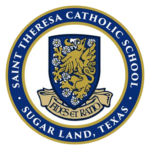
Saint Theresa Catholic School has been named one of the Top 20 Schools in the Classic Learning Test’s 2022 School Rankings. This award recognizes Saint Theresa Catholic School’s student body for collectively receiving one of the highest average scores on the CLT8 across North America in the 2021-2022 academic year.
